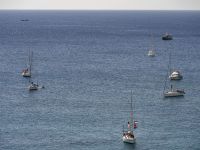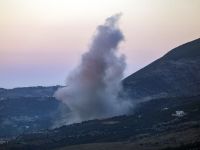In 2000, the Persian Gulf countries (Bahrain, Iran, Iraq, Kuwait, Qatar, Saudi Arabia, and the United Arab Emirates) produced nearly 28 percent of the world's oil, while holding 65 percent of the world's oil reserves.
Persian Gulf net oil exports to OECD countries increased slightly to 10.0 million barrels per day (bbl/d) in the first 9 months of 2000 from 9.8 million bbl/d for the whole of 1999.
OECD oil imports from the Persian Gulf accounted for nearly half of total OECD oil imports during that period. Besides oil, the Persian Gulf region also has huge reserves (1,800 trillion cubic feet -- Tcf) of natural gas, accounting for 34 percent of total proven world gas reserves.
General Background:
The Persian Gulf, also known as the Arabian Gulf, is a 600-mile-long body of water which separates Iran from the Arabian Peninsula, and one of the most strategic waterways in the world due to its importance in world oil transportation.
At its narrowest point (the Strait of Hormuz), the Gulf narrows to only 34 miles wide. There have been, and continue to be, significant territorial disputes between Persian Gulf countries.
Besides the Iraqi invasion of Kuwait in August 1990, and before that the Iran-Iraq War from 1980 to 1988, another important dispute is between the UAE and Iran over ownership of three islands -- Abu Musa, Greater Tunb Island, and Lesser Tunb Island, all strategically located in the Strait of Hormuz.
The three islands were effectively occupied by Iranian troops in 1992. In 1995, the Iranian Foreign Ministry claimed that the islands are "an inseparable part of Iran."
Iran rejected a 1996 proposal by the Gulf Cooperation Council (GCC) for the dispute to be resolved by the International Court of Justice, an option supported by the UAE. In early 1996, Iran took further moves to strengthen its hold on the disputed islands.
These actions included starting up a power plant on Greater Tunb, opening an airport on Abu Musa, and announcing plans for construction of a new port on Abu Musa. In September 2000, Iran stated its willingness to resume talks with the UAE on the dispute.
In March 2000, Jane's Defence Weekly reported that satellite images of Abu Musa and the Tunbs did not show any evidence that Iran had fortified the islands militarily, or turned them into "unsinkable aircraft carriers capable of closing the (Hormuz) Strait during a crisis."
In February 1991, Iraqi troops, before being expelled from Kuwait by coalition forces, dumped millions of barrels of oil into the Persian Gulf, creating an environmental crisis and also threatening desalination plants in the region.
During the Iran-Iraq War, oil tankers were attacked in the Persian Gulf by both Iraq and Iran, leading in part to the U.S. decision in 1987 to "reflag" Kuwait tankers and also to increase U.S. naval forces in the Persian Gulf.
Oil and Gas reserves, production, capacity:
The Persian Gulf in 2000 contained around 672 billion barrels of proven oil reserves, representing approximately 65 percent of total world oil reserves, and 1.8 Tcf of natural gas reserves (34 percent of the world total).
Also in 2000, the Persian Gulf maintained about 23 million bbl/d of oil production capacity, or nearly 30 percent of the world total, and accounted for 28 percent of world oil production.
Perhaps even more significantly, the Persian Gulf countries maintained a significant percentage (around 44 percent, or 1.6 million bbl/d) of the world's excess oil production capacity. This is important because in the event of an oil supply disruption, excess oil production capacity can be brought online to compensate.
If such a disruption were to occur in the Persian Gulf, it would leave the world with relatively limited options for making up the lost oil production.
In 2000, Persian Gulf countries had estimated net oil exports of 17.5 million bbl/d of oil (see pie chart), about 1.2 million bbl/d more than in 1999. OPEC production increases, undertaken in an effort to reduce high world oil prices, accounted for much of this increase.
Saudi Arabia exported the most oil of any Persian Gulf country in 2000, with an estimated 7.7 million bbl/d (44 percent of the total).
Also in 2000, Iran had estimated net exports of around 2.6 million bbl/d (15 percent), followed by Iraq (2.2 million bbl/d -- 12.5 percent), the United Arab Emirates (2.2 million bbl/d -- 12.5 percent); Kuwait (2.0 million bbl/d -- 12 percent), Qatar (0.8 million bbl/d -- 4.5 percent), and Bahrain (0.02 million bbl/d -- 0.1 percent).
Iraqi exports increased slightly between 1999 and 2000, from 2.1 million bbl/d in 1999 to an estimated 2.2 million bbl/d in 2000.
According to the Energy Information Administration's International Energy Outlook 2000, Persian Gulf oil production capacity is expected to reach 31.4 million bbl/d by 2010, and 44.8 million bbl/d by 2020, from around 23 million bbl/d currently. This would increase Persian Gulf oil production capacity to 39 percent of the world total by 2020, from 29 percent in 2000.
Offshore Persian Gulf Oil Development:Major offshore Persian Gulf oil fields include Khafji and Hout, both of which are connected to Saudi Arabia's Safaniyah, the world's largest offshore oilfield (with estimated reserves of 19 billion barrels).
Saudi offshore Persian Gulf production includes Arab Medium crude from the Zuluf (over 500,000 bbl/d capacity) and Marjan (270,000 bbl/d capacity) fields and Arab Heavy crude from the Safaniya field.
Iran's national oil company (NIOC) has expressed interest in developing five oil and gas fields in the Hormuz region (Henjam A (HA), HB, HC, HD, and HE), which, according to NIOC, hold an estimated 400 million barrels of oil and have production potential of 80,000 bbl/d.
Offshore Persian Gulf Natural Gas Development: Besides oil, the Persian Gulf region also is important because it contains huge reserves (1,800 trillion cubic feet -- Tcf) of natural gas, with Iran and Qatar holding the world's second and third-largest reserves (behind Russia), respectively.
This likely will become increasingly important in coming years, as both domestic gas consumption and gas exports (by pipeline and also by liquefied natural gas -- LNG -- tanker) increase.
In late 2000, Saudi Arabia resolved a long-standing offshore Persian Gulf border dispute with Kuwait, opening the door to development of the huge (13-Tcf) Dorra gas field, which lies in waters straddling Iranian, Saudi, and Kuwaiti territories.
Most of Qatar's gas is located in the North Dome Field, which contains 380 Tcf of in-place and 239 Tcf of recoverable reserves, making it the largest known non-associated gas field in the world. The Qatari government believes that the country's economic future lies in developing this vast gas potential.
Currently, Qatar has two LNG exporters: Qatar LNG Company (Qatargas); and Ras Laffan LNG Company (Rasgas). The Dolphin Project would supply gas from Qatar's North Dome to the United Arab Emirates, Oman, and possibly Pakistan at some point in the future (although at present this seems unlikely).
Another major Persian Gulf offshore gas project is Iran's huge South Pars field. On September 29, 1997, Total (now TotalFinaElf) signed a $2-billion deal (along with Russia's Gazprom and Malaysia's Petronas) to explore South Pars and to help develop the field during Phase 2 and 3 of its development.
NIOC estimates that South Pars has a gas production potential of up to 8 billion cubic feet per day (Bcf/d) from four individual reservoirs, possibly beginning in 2001.
In July 2000, Italian firm ENI signed a $3.8-billion deal with Iran to develop the South Pars region for gas. The deal reportedly was the largest between Iran and a foreign company since the 1979 Islamic Revolution.
In addition to South Pars, Iran aims to develop the 6.4-Tcf, non-associated Khuff (Dalan) reservoir of the Salman oil field, which straddles Iran's maritime border with Abu Dhabi, where it is known as the Abu Koosh field.
NIOC is seeking to develop the Khuff reservoir, which could lead to the production of 500 Mmcf/d of non-associated gas, along with the 120,000 bbl/d of crude oil that is now being produced from a shallower reservoir.
Also, the 47-Tcf North Pars development will be integral to Iran's long-term gas utilization plans. Development plans call for 3.6 Bcf/d of gas production, of which 1.2 Bcf/d would be re-injected into the onshore Gachsaran, Bibi Hakimeh, and Binak oil fields.
The other 2.4 Bcf/d would be sent to the more mature Agha Jari oil field. Negotiations on the field stalled in 1995, but Shell reportedly renewed its interest in 1998.
Oil Flows: Strait of Hormuz - In 2000, the vast majority (nearly 90 percent) of oil exported from the Persian Gulf transited by tanker through the Strait of Hormuz, located between Oman and Iran, and onwards.
By far the world's most important oil "chokepoint," accounting for transit of around two-fifths of all world traded oil, the Strait consists of 2-mile wide channels for inbound and outbound tanker traffic, as well as a 2-mile wide buffer zone.
Closure of the Strait of Hormuz would require use of longer alternate routes (if available) at increased transportation costs.
Such routes include the 5 million-bbl/d-capacity East-West Pipeline across Saudi Arabia to the port of Yanbu, and the Abqaiq-Yanbu natural gas liquids line across Saudi Arabia to the Red Sea.
The more than 15 million bbl/d of oil which transit the Strait of Hormuz goes all over the world, eastwards to Asia (especially Japan, China, and India) and westwards (via the Suez Canal, the Sumed pipeline, or around the Cape of Good Hope in South Africa) to Western Europe and the United States.
Another route for Saudi oil exports which reportedly has been under is through Yemen to the Gulf of Aden.
Bab al-Mandab: Oil heading westwards by tanker from the Persian Gulf towards the Suez Canal or Sumed pipeline must pass through the Bab al-Mandab.
Located between Djibouti and Eritrea in Africa, and Yemen on the Arabian Peninsula, the Bab al-Mandab connects the Red Sea with the Gulf of Aden and the Arabian Sea.
Any closure of the Bab al-Mandab could keep tankers from reaching the Suez Canal/Sumed Pipeline complex, diverting them around the southern tip of Africa.
This would add greatly to transit time and cost, and effectively tie up spare tanker capacity. In December 1995, Yemen fought a brief battle with Eritrea over Greater Hanish Island, located just north of the Bab al-Mandab.
The Bab al-Mandab could be bypassed by utilizing the East-West oil pipeline.
However, southbound oil traffic, which totaled about 1 million bbl/d in 1997, would still be blocked. In addition, closure of the Bab al-Mandab would effectively block non-oil shipping from using the Suez Canal, except for limited trade within the Red Sea region.
Source: United Sates Energy Information Administration.
© 2001 Mena Report (www.menareport.com)







